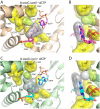Kinetics of mismatch formation opposite lesions by the replicative DNA polymerase from bacteriophage RB69
- PMID: 20166748
- PMCID: PMC2849760
- DOI: 10.1021/bi901488d
Kinetics of mismatch formation opposite lesions by the replicative DNA polymerase from bacteriophage RB69
Abstract
The fidelity of DNA replication is under constant threat from the formation of lesions within the genome. Oxidation of DNA bases leads to the formation of altered DNA bases such as 8-oxo-7,8-dihydroguanine, commonly called 8-oxoG, and 2-hydroxyadenine, or 2-OHA. In this work we have examined the incorporation kinetics opposite these two oxidatively derived lesions as well as an abasic site analogue by the replicative DNA polymerase from bacteriophage RB69. We compared the kinetic parameters for both wild type and the low fidelity L561A variant. While nucleotide incorporation rates (k(pol)) were generally higher for the variant, the presence of a lesion in the templating position reduced the ability of both the wild-type and variant DNA polymerases to form ternary enzyme-DNA-dNTP complexes. Thus, the L561A substitution does not significantly affect the ability of the RB69 DNA polymerase to recognize damaged DNA; instead, the mutation increases the probability that nucleotide incorporation will occur. We have also solved the crystal structure of the L561A variant forming an 8-oxoG.dATP mispair and show that the propensity for forming this mispair depends on an enlarged polymerase active site.
Figures





Similar articles
-
The L561A substitution in the nascent base-pair binding pocket of RB69 DNA polymerase reduces base discrimination.Biochemistry. 2006 Feb 21;45(7):2211-20. doi: 10.1021/bi052099y. Biochemistry. 2006. PMID: 16475809 Free PMC article.
-
Characterization of a replicative DNA polymerase mutant with reduced fidelity and increased translesion synthesis capacity.Nucleic Acids Res. 2008 Jul;36(12):3892-904. doi: 10.1093/nar/gkn312. Epub 2008 May 24. Nucleic Acids Res. 2008. PMID: 18503083 Free PMC article.
-
Using a fluorescent cytosine analogue tC(o) to probe the effect of the Y567 to Ala substitution on the preinsertion steps of dNMP incorporation by RB69 DNA polymerase.Biochemistry. 2012 Jun 5;51(22):4609-17. doi: 10.1021/bi300241m. Epub 2012 May 22. Biochemistry. 2012. PMID: 22616982 Free PMC article.
-
RB69 DNA polymerase structure, kinetics, and fidelity.Biochemistry. 2014 May 6;53(17):2752-67. doi: 10.1021/bi4014215. Epub 2014 Apr 23. Biochemistry. 2014. PMID: 24720884 Free PMC article. Review.
-
DNA polymerase of the T4-related bacteriophages.Prog Nucleic Acid Res Mol Biol. 2000;64:65-96. doi: 10.1016/s0079-6603(00)64002-3. Prog Nucleic Acid Res Mol Biol. 2000. PMID: 10697407 Review.
Cited by
-
Structure of New Binary and Ternary DNA Polymerase Complexes From Bacteriophage RB69.Front Mol Biosci. 2021 Nov 18;8:704813. doi: 10.3389/fmolb.2021.704813. eCollection 2021. Front Mol Biosci. 2021. PMID: 34869578 Free PMC article.
-
DNA polymerase minor groove interactions modulate mutagenic bypass of a templating 8-oxoguanine lesion.Nucleic Acids Res. 2013 Feb 1;41(3):1848-58. doi: 10.1093/nar/gks1276. Epub 2012 Dec 24. Nucleic Acids Res. 2013. PMID: 23267011 Free PMC article.
-
A crystallographic study of the role of sequence context in thymine glycol bypass by a replicative DNA polymerase serendipitously sheds light on the exonuclease complex.J Mol Biol. 2011 Sep 9;412(1):22-34. doi: 10.1016/j.jmb.2011.07.007. Epub 2011 Jul 18. J Mol Biol. 2011. PMID: 21781974 Free PMC article.
-
DNA polymerases provide a canon of strategies for translesion synthesis past oxidatively generated lesions.Curr Opin Struct Biol. 2011 Jun;21(3):358-69. doi: 10.1016/j.sbi.2011.03.008. Epub 2011 Apr 7. Curr Opin Struct Biol. 2011. PMID: 21482102 Free PMC article. Review.
-
Binary complex crystal structure of DNA polymerase β reveals multiple conformations of the templating 8-oxoguanine lesion.Proc Natl Acad Sci U S A. 2012 Jan 3;109(1):113-8. doi: 10.1073/pnas.1112235108. Epub 2011 Dec 16. Proc Natl Acad Sci U S A. 2012. PMID: 22178760 Free PMC article.
References
-
- Friedberg EC, Walker GC, Siede W. DNA repair and mutagenesis. Washington, D.C.; ASM Press: 1995.
-
- Lindahl T, Barnes DE. Repair of endogenous DNA damage. Cold Spring Harb Symp Quant Biol. 2000;65:127–133. - PubMed
-
- Wallace SS. Oxidative Damage to DNA and its Repair. In: Scandalios J, editor. Oxidative Stress and the Molecular Biology of Antioxidant Defenses. Cold Spring Harbor Laboratory Press; Cold Spring Harbor, NY: 1997. pp. 49–90.
Publication types
MeSH terms
Substances
Grants and funding
LinkOut - more resources
Full Text Sources

